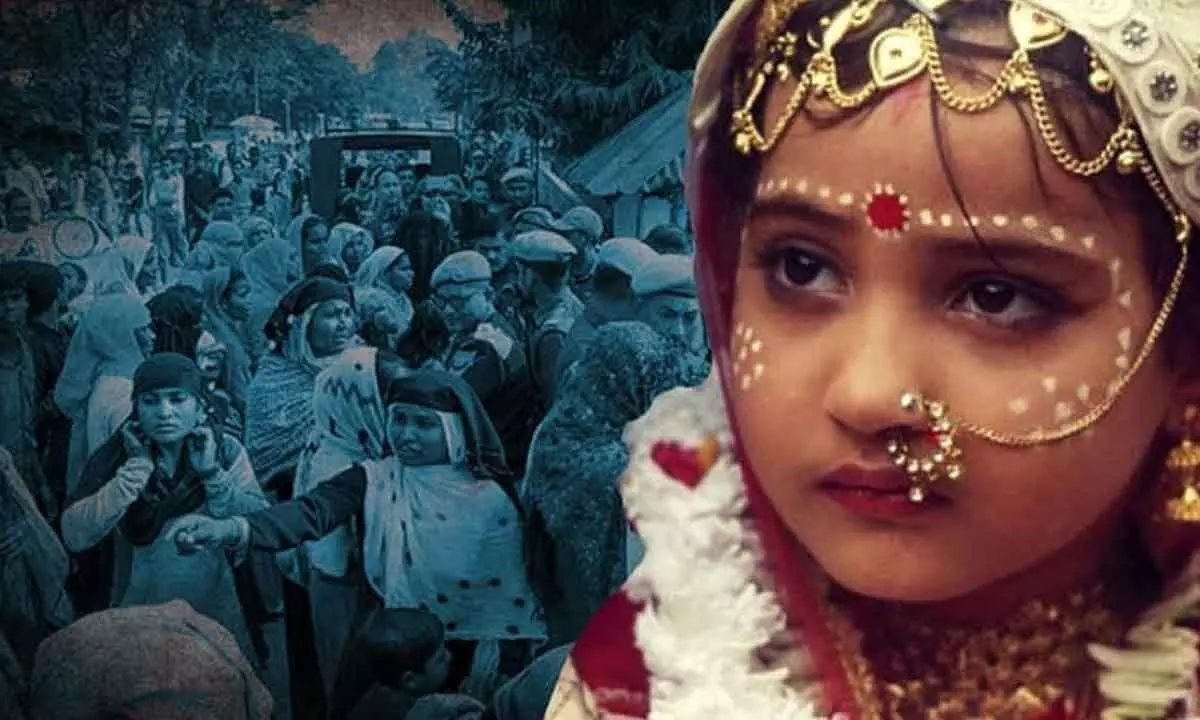
Child marriage has been a social evil prevalent in India for centuries. It is a form of exploitation and violation of child rights, which affects children’s physical, mental, and emotional well-being. To address this issue, the Indian government enacted the Child Marriage Act 2006 to safeguard children’s futures by prohibiting child marriages and protecting children’s rights. In Indian society, child marriage is not a new occurrence. It has been around for ages in India. Poverty, a lack of education, and instability are among the most prominent factors for child marriage. However, child marriage has a variety of implications. These include psychological and societal implications like denial of the right to education, early motherhood, an impediment to both boys’ and girls’ physical and mental development, and so on. Child Marriage Act.
Child marriages are more harmful to females than to boys. Girls are expected to adjust to large life changes at a young age. Girls are mostly subjected to crimes like marital rape and domestic abuse. To avert the painful repercussions of child marriage in India, the British passed the Child Marriage Restraint Act of 1929 to destroy the culture of child marriage in India. The Act was, however, abolished and replaced by the Prohibition of Child Marriage Act of 2006. This article aims to examine the many facets of India’s prohibition of underage marriages.
What is Child Marriage?
Child marriage is a marriage in which one or both parties are minors, i.e., below the age of 18 for girls and below the age of 21 for boys. It is a practice prevalent in many parts of the world, including India. Child marriage violates human rights and has adverse consequences on children’s physical, mental, and emotional health.
Effects of Child Marriage
- Child marriage has many negative effects on children, which can affect their entire lives. Some of the effects of child marriage are:
- Health issues: Child brides are more likely to suffer from health problems like malnutrition, anemia, and complications during pregnancy and childbirth.
- Education: Child brides are often forced to drop out of school, which limits their opportunities for personal and professional growth.
- Economic dependency: Child brides are often economically dependent on their husbands and cannot contribute to the household income.
- Domestic violence: Child brides are at a higher risk of domestic violence and abuse, as they are often powerless to resist their husbands’ demands.
- Mental health: Child brides are more likely to suffer from mental health issues like depression, anxiety, and post-traumatic stress disorder.
Child Marriage Act, 2006
The Child Marriage Act 2006 is an important legislation to prevent child marriages and protect children’s rights. The Act defines child marriage as a marriage in which either the bride or the groom is below the age of 18 years. The Act makes child marriage a punishable offense, with imprisonment and/or a fine.
Prohibition of Child Marriage (Amendment) Bill 2021
21 December 2021 was the date when the Prohibition of Child Marriage Amendment Bill was introduced. The Bill amended the Prohibition of Child Marriage Act 2006, increasing the age at which girls can marry from 18 to 21. It also amended related marriage laws such as the Hindu and special marriage acts.
The Child Marriage Act 2006 has the following provisions:
- Prohibition of child marriage: The Act prohibits the solemnization of child marriages. Any person who performs conducts or abets a child marriage can be punished with imprisonment and/or a fine.
- Child marriages voidable: Any child marriage can be declared voidable at the option of the child bride or groom. The child can file a petition in the court to declare the marriage void within two years of attaining the age of majority.
- Punishment for promoting child marriages: The Act provides for punishment for promoting child marriages, which includes the promotion of child marriages through advertisements, posters, or other means.
- Child marriage prevention officers: The Act provides for the appointment of child marriage prevention officers responsible for preventing child marriages in their jurisdiction.
- Child protection: The Act provides for the protection and rehabilitation of child brides and grooms, including medical care, counseling, and education.
- Awareness and sensitization: The Act promotes awareness and sensitization programs to prevent child marriages and protect children’s rights.
Section 3
It states that whether a child marriage was performed before or after the Act’s implementation is voidable at the discretion of the party to the wedding, which was a minor during the ceremony. If a district court is pleased with the application, it may issue an annulment decree.
Section 4
It states that the district court has the authority to issue an interim order for the female child’s maintenance while issuing a decree under Section 3 to guarantee that the girl child can meet her requirements. The court may even appoint guardians for the male kid if it is determined that he is a juvenile under the Majority Act of 1875.
Section 6
It states that if a child is conceived due to child marriage, regardless of whether a judgment of annulment has been issued under Section 3, the child is considered legitimate for all purposes.
Section 9
It specifies the penalty for an adult male who performs a child marriage, which is severe imprisonment for a term not exceeding two years or a fine of a maximum of ₹1,00,000, or maybe both.
Section 10
It states that anybody who executes, conducts, directs, or lends a hand in any child marriage is penalized by imprisonment for a maximum of 2 years and a fine of a maximum of ₹1,00,000.
Section 11
It states that anybody who encourages or carelessly fails to prevent the solemnization of child marriage is penalized by harsh imprisonment for a maximum of 2 years and a fine of a whopping ₹1,00,000. The provision also makes attending and engaging in child marriage illegal. Women are excluded from incarceration under the provision’s proviso.
Section 12
It states that if a child under the age of 18 is seduced out of the custody of his or her legal guardian, is coerced, compelled, or tricked, or is trafficked or exploited for immoral purposes, and the such kid is forced to solemnize a child marriage; the marriage is void from the start.
Section 16
It allows the State Government to appoint the Child Marriage Prohibition Officer and the officer’s responsibilities and powers. The duties include:
- Preventing the solemnization of child marriages in areas under their jurisdiction.
- Gathering evidence for the prosecution of offenders under the Act.
- Raising awareness about the consequences of child marriage.
- Gathering statistics on child marriage in areas under their jurisdiction.
The official may also petition the district court for the annulment of any child marriage.
Conclusion
The Child Marriage Act 2006 is an important legislation to prevent child marriages and protect children’s rights. Child marriage is a social evil that adversely affects children’s physical, mental, and emotional health. The Act prohibits child marriages, makes it a punishable offense, and provides for the protection and rehabilitation of child brides and grooms. The Act also provides for the appointment of child marriage prevention officers, awareness and sensitization programs, and the promotion of children’s rights. Implementing the Act is crucial to safeguard children’s future and ensuring their well-being.
Marriage Registration in Thane
Marriage Registration in Malabarhills
Marriage Registration in Cuffeparade
Marriage Registration in Juhu
Marriage Registration in Tardeo
Marriage Registration in Bandra West
Marriage Registration in Worli
Marriage Registration in Dadar
Marriage Registration in Byculla
Marriage Registration in Santacruz
Marriage Registration in Mahim
Marriage Registration in Vasai
Marriage Registration in Bandra East
Marriage Registration in Raigad
Marriage Registration in Andheri East
Marriage Registration in Ghatkopar
Marriage Registration in Bhandup
Marriage Registration in Mumbai Central
Marriage Registration in Kurla
Marriage Registration in Churchgate
Marriage Registration in lalbaugh
Marriage Registration in Navy Nagar
Marriage Registration in Dharavi
Marriage Registration in Nariman Point
Marriage Registration in Kalbadevi
Marriage Registration in Grant Road
Marriage Registration in Malad
Marriage Registration in Borivali
Marriage Registration in Dombivli
Marriage Registration in Palghar
Court Marriage Registration in Pune
Best Family Lawyer in Mumbai
Court Marriage Registration in Mumbai
Court Marriage Registratio in Thane
Court Marriage Registratioc in Pune
Court Marriage Registratio in Mumbai
Court Marriage Registratio in Nashik
Legal Service Provider in Mumbai, Thane, Pune
Marriage Registration in Mumbai
Court Marriage Registration in Mumbai


